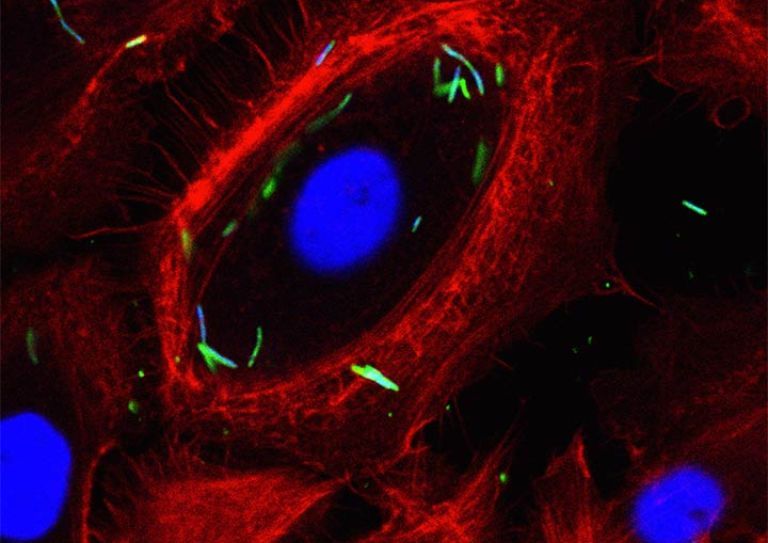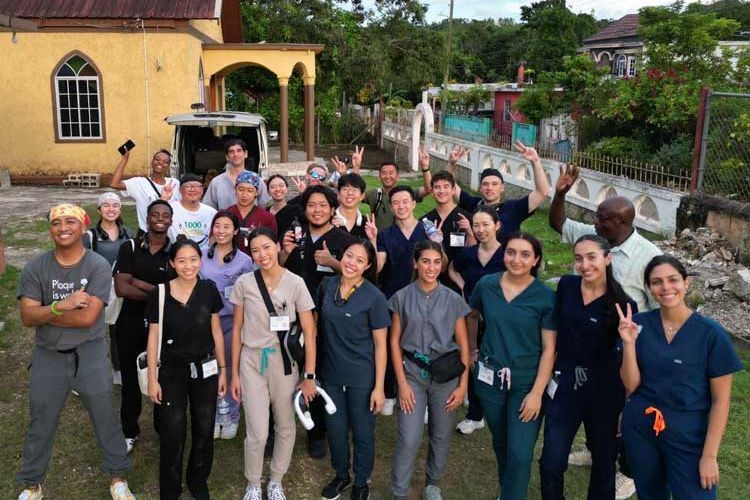Breadcrumb
Fusobacterium Nucleatum Infection of Gingival Epithelial Cells Leads to NLRP3 Inflammasome-Dependent Secretion of IL-1β and the Danger Signals ASC and HMGB1
What problem does it aim to solve?
Periodontitis is one of the most common chronic diseases in the world. Understanding how the immune system recognizes the bacteria that cause periodontal disease could be helpful in preventing it.
How does it work?
Researchers infected cells with F. nucleatum, then examined the response of the cells with a variety of cellular and molecular methods over time. They found that this infection sets off a cascade of responses by the immune system. More specifically, F. nucleatum infection activates NF-κB (a protein complex that controls transcription of DNA, cytokine production and cell survival), which translocates to the nucleus, where it stimulates expression of pro-inflammatory genes, including genes encoding the precursor to the cytokine protein IL-1β, or pro-IL-1β. In addition, infection activates the NLRP3 inflammasome, which in turns activates the enzyme caspase-1, resulting in processing and release of mature IL-1β. Inflammation is magnified further by release of the danger signal ASC, and the protein HMGB1, which is otherwise bound to chromatin in the nucleus.
What are the real-world implications?
In the short term, researchers have gained a greater understanding of the complex response to bacterial infection in gingival epithelial cells. In the long term, perhaps periodontal disease could be treated by targeting/enhancing the immune response in the oral cavity.
What are the next steps?
These studies were performed with gingival cell lines in culture. Other genes modulate the activity of the inflammasome itself. The researchers plan to study the inflammasome and the genes that regulate the inflammasome in an animal model of oral infection, and examine the function of these genes in human periodontal disease.

Intracellular localization of Fusobacterium nucleatum in GECs. Immunofluorescence confocal micrograph GECs infected with F. nucleatum (MOI of 100) for 1 h. The single optical section through the middle of the host cell confirms the intracellular localization of the bacteria. Fixed GECs were stained with phalloidin-tetramethylrhodamine B isothiocyanate (red) to show actin filaments, and anti-F. nucleatum antibody (green). Bar represents 20 µm.
Source
Fusobacterium nucleatum infection of gingival epithelial cells leads to NLRP3 inflammasome-dependent secretion of IL-1β and the danger signals ASC and HMGB1, Volume 18, issue 7, July 2016, Pages 970-981
Authors
Fiona Q. Bui
Department of Biomedical Sciences, University of the
Pacific, Arthur Dugoni School of Dentistry
Larry Johnson
Department of Biomedical Sciences, University of the
Pacific, Arthur Dugoni School of Dentistry
Immunobiology Program, Instituto de Biofísica Carlos
Chagas Filho, Federal University of Rio de Janeiro
JoAnn Roberts
Department of Periodontology and Emerging Pathogens
Institute, University of Florida, Gainesville
Shu-Chen Hung,
Department of Biomedical Sciences, University of the
Pacific, Arthur Dugoni School of Dentistry
Jungnam Lee
Department of Periodontology and Emerging Pathogens
Institute, University of Florida, Gainesville
Kalina Rosenova Atanasova
Department of Periodontology and Emerging Pathogens
Institute, University of Florida, Gainesville
Pei-Rong Huang
Center for Molecular and Clinical Immunology, Chang
Gung University, Taiwan
Özlem Yilmaz
Department of Periodontology and Emerging Pathogens
Institute, University of Florida, Gainesville
David M. Ojcius
Department of Biomedical Sciences, University of the
Pacific, Arthur Dugoni School of Dentistry






